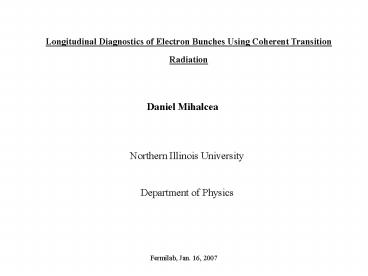Longitudinal Diagnostics of Electron Bunches Using Coherent Transition Radiation
1 / 22
Title:
Longitudinal Diagnostics of Electron Bunches Using Coherent Transition Radiation
Description:
Department of Physics. Fermilab/NICADD overview. Michelson interferometer ... (University of Georgia & NIU) Autocorrelation = I1/I2. Detectors: - Molectron pyro ... –
Number of Views:46
Avg rating:3.0/5.0
Title: Longitudinal Diagnostics of Electron Bunches Using Coherent Transition Radiation
1
Longitudinal Diagnostics of Electron Bunches
Using Coherent Transition Radiation
Daniel Mihalcea
Northern Illinois University Department of
Physics
2
Outline
- Fermilab/NICADD overview
- Michelson interferometer
- Bunch shape determination
- Experimental results
- Conclusions
3
Fermilab NICADD Photo-injector Laboratory
- FNPL is a collaborative effort of several
institutes and universities to operate a
high-brightness photo-injector dedicated to
accelerator and beam physics research. - Collaborators include
U. of Chicago, U. of Rochester, UCLA, U. of
Indiana, U. of Michigan, LBNL, NIU, U. of
Georgia, Jlab, Cornell University
DESY, INFN-Milano, IPN-Orsay, CEA-Saclay
4
FNPL layout
Michelson interferometer for longitudinal
diagnostics
5
Michelson Interferometer (University of Georgia
NIU)
Autocorrelation I1/I2
- Molectron pyro-electric - Golay cell
(opto-acoustic)
Detectors
6
Data Flow
Get Q
Get I1 and I2
LabView code
- Advances stepping motor between x1 and x2 with
adjustable step size (50 ?m) - At each position there are N readings (5)
- A reading is valid if bunch charge is within
some narrow window (Ex 1nC ? 0.1 nC) - Position, average values of I1 and I2 and their
?s are recorded. - Autocorrelation function is displayed.
7
Basic Principle (1)
Backward transition radiation
Ginsburg-Franck
Detector aperture ? 1 cm
8
Basic Principle (2)
Intensity of Optical Transition Radiation
Coherent part ? N2
To determine ?(z) need to know I(?) and the
phase of f(?)
Kramers-Kröning technique
9
Coherence condition
Due to detector sensitivity
Acceptable resolution
Need bunch compression !
10
Bunch Compression
RF field in booster cavity
Energy-Position correlation
Electron bunch before compression
Tail
After compression
Head
11
Measurement Steps
FT
Ideal apparatus
K-K
12
Experimental results (1)
13
Experimental results (2)
Still need to account for
- low detector sensitivity at low frequencies
- diffraction at low frequencies
- absorption at large frequencies
Golay detectors no problem with interference !
14
Experimental results (3)
Interference
Apparatus response function
Absorption
Diffraction
Low detector sensitivity
15
Experimental results (4)
Molectron pyroelectric detectors
16
Experimental results (5)
- Molectron pyroelectric detectors
- Kramers-Kroning method
Head-Tail ambiguity
Parmela simulation
Head
Tail
17
Experimental results (6)
Golay cell
- FT
- Spectrum correction with R(?)
- Spectrum completion for
and
Start point
K-K
?z ? 1ps
18
Complicated bunch shapes
Stack 4 laser pulses
Select 1st and 4th pulses (?t ?15ps)
After compression
Before compression
(Parmela simulations)
19
Experimental results (7)
Double-peaked bunch shapes
K-K method may not be accurate for complicate
bunch shapes !
20
K-K method accuracy
R. Lai and A. J. Sievers, Physical Review E, 52,
4576, (1995)
Generated
Reconstructed
K-K method accurate if
- Simple bunch structure
- Stronger component comes first
Calculated widths are still correct !
21
Other approaches
Major problem the response function is not flat.
1. Complete I(?) based on some assumptions at low
and high frequencies. R. Lai, et al. Physical
Review E, 50, R4294, (1994). S. Zhang, et al.
JLAB-TN-04-024, (2004). 2. Avoid K-K method by
assuming that bunches have a predefined shape and
make some assumptions about I(?) at low
frequencies. A. Murokh, et al. NIM A410,
452-460, (1998). M. Geitz, et al. Proceedings
PAC99, p2172, (1999).
This work
D. Mihalcea, C. L. Bohn, U. Happek and P. Piot,
Phys. Rev. ST Accel. Beams 9, 082801 (2006).
22
Conclusions
- Longitudinal profiles with bunch lengths less
than 0.6 mm can - be measured.
- Systematic uncertainties dominated by
approximate knowledge of response function and
completion procedure. - Golay cells are better because the response
function is more uniform. - Some complicate shapes (like double-peaked
bunches) can be measured.






























